
SIGRID
DEPTH: 20 - 32 m
SKILL: All
Sigrid (ex-Mariann); motor merchant ship; Cyprus
Built: Launched 4th August 1956, Unterweser, Bremerhaven, Germany
Sunk: 15th January 1977 (bad weather)
Dimensions: l=72.3 m, w=10.8 m
Coordinates: 45.32487° N, 14.42885° E
Location: in front of the port of Rijeka, outer side of the Rijeka breakwater
Access: 5/5 access is possible by boat and from the land
Visibility: 4/5 clear, occasionally very good visibility
Current: 4/5 mostly weak current
Flora and fauna: 5/5 varied life on and around the wreck, large specimens of various species of fish
HISTORY:
The merchant ship Mariann of 1,063 tonnes was launched in the German shipyard Unterweser in Bremerhaven on 4th August 1956, and within half of the following year it was sold to the ship owner Helmsing & Co. from Bremen. It sailed under the same flag up until 1972 when it was sold to the Baltmed Shipping Co. Ltd. from Cyprus and its name was changed to Sigrid and its home port was Famagusta. It was a relatively small ship, such of which were often encountered in the merchant traffic of the Mediterranean and Adriatic.
The ship sailed to the port of Rijeka on 12th January 1977 from the French port of Bordeaux with a cargo of 174 tonnes of machinery loaded in 60 wooden crates. Due to the port being overcrowded the ship anchored about 800 metres in front of the Rijeka breakwater. It was a time when everyday about twenty or so ships would be queuing in front of Rijeka’s port waiting to be moored, as the port worked at full steam. During the night of 14th-15th January a strong “jugo” (pronounced “yugo”) SE wind began to blow which soon reached force eight on the Beaufort scale, and ever increasing waves began to move the Sigrid towards the breakwater. Another anchor which was lowered also did not help. At around 0440 hrs. the commander requested the help of a tug by radio contact, and at the same time ordered that the engine be started up at full power so as to move the ship away from the breakwater. However this manoeuvre did not succeed, as the propeller which had hit the underwater part of the breakwater was damaged. When two tugs finally arrived at the Sigrid, the ship had already crashed into the breakwater and water had begun to flood into the forward cargo hold.
On the listing ship the crew no longer knew what to do. Frozen, in shock and in pyjamas, they all pulled on life jackets and gathered at the stern. It was daybreak, and the unlucky ship crashed into the rocks. From the coast rescuers threw a rope which members of the crew tied to bitts on the stern. So by using the stretched rope, the members of the crew one by one made it to the land where the rescuers were waiting for them. The sea breached more and more into the Sigrid and after 25 minutes it disappeared under the surface.
After a year of wrangling with the ship owner, the cargo's owners and insurers, the port authorities managed to gain permission to remove the cargo from the wreck – machinery for the Matroz factory from Sremska Mitrovica in Serbia. This arduous work was carried out by heavy divers of the Sailing Fleet of the Port of Rijeka. After a very difficult and complicated operation all 60 crates of the machinery were pulled from the wreck, also removed was the entire bow section of the ship. The cutting up of the wreck continued for some time so that over several following years the masts and part of the superstructure were cut from under the water. However the work was interrupted for some reason and what remained of the wreck was left to the sea…
WRECK CONDITION AND DIVING:
The wreck of the Sigrid is unique in that it is one of the rare wrecks in the Adriatic whose immediate vicinity means can it be reached by car and dived on from the land, which is possible through an authorised diving centre. One problem is that the outer side of the breakwater is constructed from piles of large stone boulders and blocks making access quite difficult with diving equipment. Therefore a more comfortable option is to dive from a boat, again through an authorised diving centre which can reach the location in less than fifteen minutes drive from the port of Rijeka. The wreck is located only thirty metres from the Rijeka breakwater and its position is marked with a buoy which was placed for diving. Descending following the anchored rope at a depth of ten metres we can already perceive the ship’s hull which lies obliquely to the direction of the breakwater, with the stern turned towards the west. With good visibility, which is often from 15 to up 25 metres, we can immediately see the place where the front section of the ship is missing its bow, because the hull suddenly ends and in place of the bow there gapes a huge hole. The rope is tied in the place where the main mast once was, this was removed during the period when the ship being cut up, probably so that it did not present a danger to navigation. Although the mast is no longer there, in this spot the crane winches are well-preserved as well as various vents and railings. Swimming towards the stern section of the ship we pass above the open cargo hold which is empty, and we arrive at the superstructure which is located at the end of the stern.
Until recently there was also a bell on the side of the bridge, which surprisingly no one had noticed until one of the diving teams noted and photographed it. Unfortunately, after only a few days after its discovery it disappeared without trace and so this wreck was deprived of yet one more attraction. On the lower floor of the superstructure a large part of the front wall is missing so entry is easy. With care one can pass through some areas towards the stern, trying of course not to whip up the very fine silt which is everywhere on the wreck. The funnel is still in place, as is the mast of the radar antenna on the right side of the bridge. Around it there permanently gathers a large shoal of damselfish which are not scared of divers so one can get quite close to them. On the superstructure the lifeboat davits, the winches for lowering the boats as well as a small manual crane at the end of the stern are still in situ. A thick nylon rope is still wound on the bitt, here one can also find large groupers which are not uncommon on wrecks, and especially on those in Kvarner. Descending below the top of the stern towards the bottom we come across the large propeller and the blade of the rudder, which are still not overgrown with marine vegetation, probably because of the underwater paint which can still be seen on the underwater parts of the ship.
Swimming back towards the bow section of the ship we arrive at the point where the ship has been cut, at the level of the forward cargo hold. The whole fore section of cargo hold is missing, so we can easily swim into the interior, where in the half-darkness hide groupers and the occasional conger eel. Nearby is also the base of the foremast where the anchor rope is tied, and so this is also the place from which we begin our ascent.
The description and illustrations are a courtesy of Danijel Frka and Jasen Mesić. Buy the whole book here: https://shop.naklada-val.hr/product_info.php?products_id=561
Built: Launched 4th August 1956, Unterweser, Bremerhaven, Germany
Sunk: 15th January 1977 (bad weather)
Dimensions: l=72.3 m, w=10.8 m
Coordinates: 45.32487° N, 14.42885° E
Location: in front of the port of Rijeka, outer side of the Rijeka breakwater
Access: 5/5 access is possible by boat and from the land
Visibility: 4/5 clear, occasionally very good visibility
Current: 4/5 mostly weak current
Flora and fauna: 5/5 varied life on and around the wreck, large specimens of various species of fish
HISTORY:
The merchant ship Mariann of 1,063 tonnes was launched in the German shipyard Unterweser in Bremerhaven on 4th August 1956, and within half of the following year it was sold to the ship owner Helmsing & Co. from Bremen. It sailed under the same flag up until 1972 when it was sold to the Baltmed Shipping Co. Ltd. from Cyprus and its name was changed to Sigrid and its home port was Famagusta. It was a relatively small ship, such of which were often encountered in the merchant traffic of the Mediterranean and Adriatic.
The ship sailed to the port of Rijeka on 12th January 1977 from the French port of Bordeaux with a cargo of 174 tonnes of machinery loaded in 60 wooden crates. Due to the port being overcrowded the ship anchored about 800 metres in front of the Rijeka breakwater. It was a time when everyday about twenty or so ships would be queuing in front of Rijeka’s port waiting to be moored, as the port worked at full steam. During the night of 14th-15th January a strong “jugo” (pronounced “yugo”) SE wind began to blow which soon reached force eight on the Beaufort scale, and ever increasing waves began to move the Sigrid towards the breakwater. Another anchor which was lowered also did not help. At around 0440 hrs. the commander requested the help of a tug by radio contact, and at the same time ordered that the engine be started up at full power so as to move the ship away from the breakwater. However this manoeuvre did not succeed, as the propeller which had hit the underwater part of the breakwater was damaged. When two tugs finally arrived at the Sigrid, the ship had already crashed into the breakwater and water had begun to flood into the forward cargo hold.
On the listing ship the crew no longer knew what to do. Frozen, in shock and in pyjamas, they all pulled on life jackets and gathered at the stern. It was daybreak, and the unlucky ship crashed into the rocks. From the coast rescuers threw a rope which members of the crew tied to bitts on the stern. So by using the stretched rope, the members of the crew one by one made it to the land where the rescuers were waiting for them. The sea breached more and more into the Sigrid and after 25 minutes it disappeared under the surface.
After a year of wrangling with the ship owner, the cargo's owners and insurers, the port authorities managed to gain permission to remove the cargo from the wreck – machinery for the Matroz factory from Sremska Mitrovica in Serbia. This arduous work was carried out by heavy divers of the Sailing Fleet of the Port of Rijeka. After a very difficult and complicated operation all 60 crates of the machinery were pulled from the wreck, also removed was the entire bow section of the ship. The cutting up of the wreck continued for some time so that over several following years the masts and part of the superstructure were cut from under the water. However the work was interrupted for some reason and what remained of the wreck was left to the sea…
WRECK CONDITION AND DIVING:
The wreck of the Sigrid is unique in that it is one of the rare wrecks in the Adriatic whose immediate vicinity means can it be reached by car and dived on from the land, which is possible through an authorised diving centre. One problem is that the outer side of the breakwater is constructed from piles of large stone boulders and blocks making access quite difficult with diving equipment. Therefore a more comfortable option is to dive from a boat, again through an authorised diving centre which can reach the location in less than fifteen minutes drive from the port of Rijeka. The wreck is located only thirty metres from the Rijeka breakwater and its position is marked with a buoy which was placed for diving. Descending following the anchored rope at a depth of ten metres we can already perceive the ship’s hull which lies obliquely to the direction of the breakwater, with the stern turned towards the west. With good visibility, which is often from 15 to up 25 metres, we can immediately see the place where the front section of the ship is missing its bow, because the hull suddenly ends and in place of the bow there gapes a huge hole. The rope is tied in the place where the main mast once was, this was removed during the period when the ship being cut up, probably so that it did not present a danger to navigation. Although the mast is no longer there, in this spot the crane winches are well-preserved as well as various vents and railings. Swimming towards the stern section of the ship we pass above the open cargo hold which is empty, and we arrive at the superstructure which is located at the end of the stern.
Until recently there was also a bell on the side of the bridge, which surprisingly no one had noticed until one of the diving teams noted and photographed it. Unfortunately, after only a few days after its discovery it disappeared without trace and so this wreck was deprived of yet one more attraction. On the lower floor of the superstructure a large part of the front wall is missing so entry is easy. With care one can pass through some areas towards the stern, trying of course not to whip up the very fine silt which is everywhere on the wreck. The funnel is still in place, as is the mast of the radar antenna on the right side of the bridge. Around it there permanently gathers a large shoal of damselfish which are not scared of divers so one can get quite close to them. On the superstructure the lifeboat davits, the winches for lowering the boats as well as a small manual crane at the end of the stern are still in situ. A thick nylon rope is still wound on the bitt, here one can also find large groupers which are not uncommon on wrecks, and especially on those in Kvarner. Descending below the top of the stern towards the bottom we come across the large propeller and the blade of the rudder, which are still not overgrown with marine vegetation, probably because of the underwater paint which can still be seen on the underwater parts of the ship.
Swimming back towards the bow section of the ship we arrive at the point where the ship has been cut, at the level of the forward cargo hold. The whole fore section of cargo hold is missing, so we can easily swim into the interior, where in the half-darkness hide groupers and the occasional conger eel. Nearby is also the base of the foremast where the anchor rope is tied, and so this is also the place from which we begin our ascent.
The description and illustrations are a courtesy of Danijel Frka and Jasen Mesić. Buy the whole book here: https://shop.naklada-val.hr/product_info.php?products_id=561


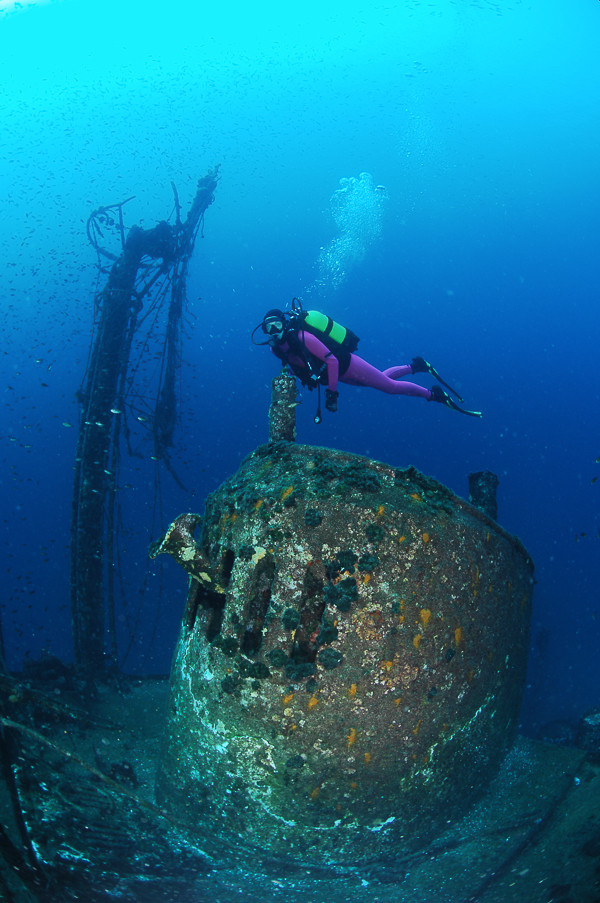
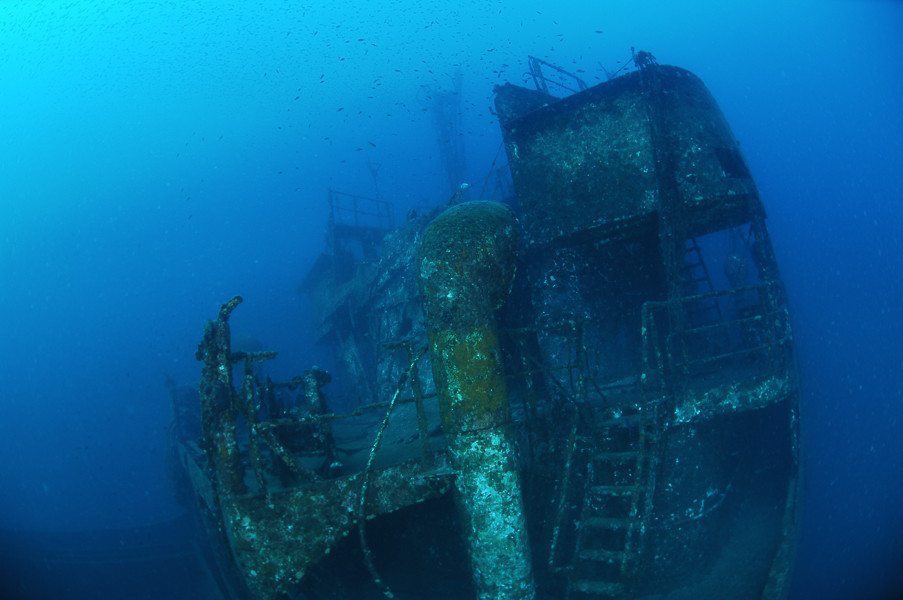
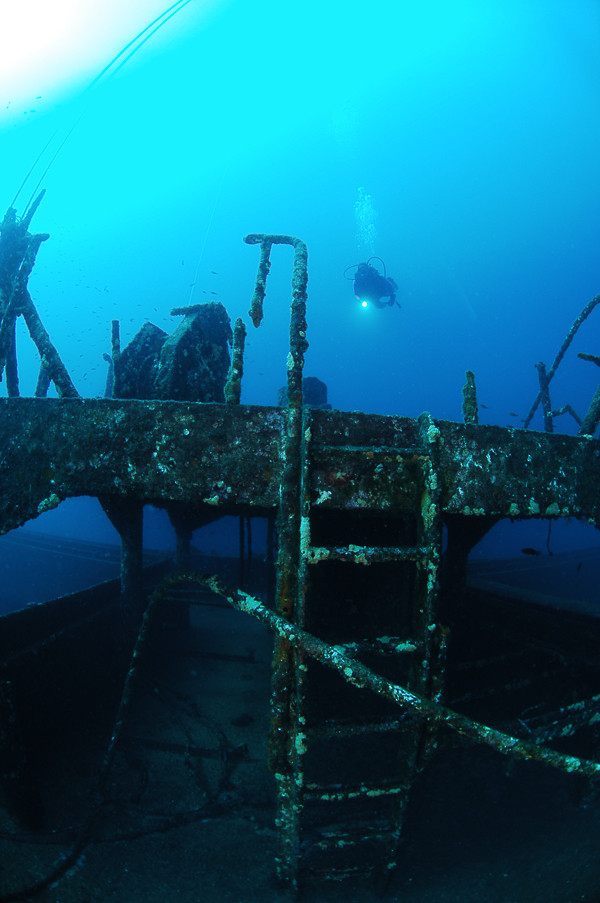
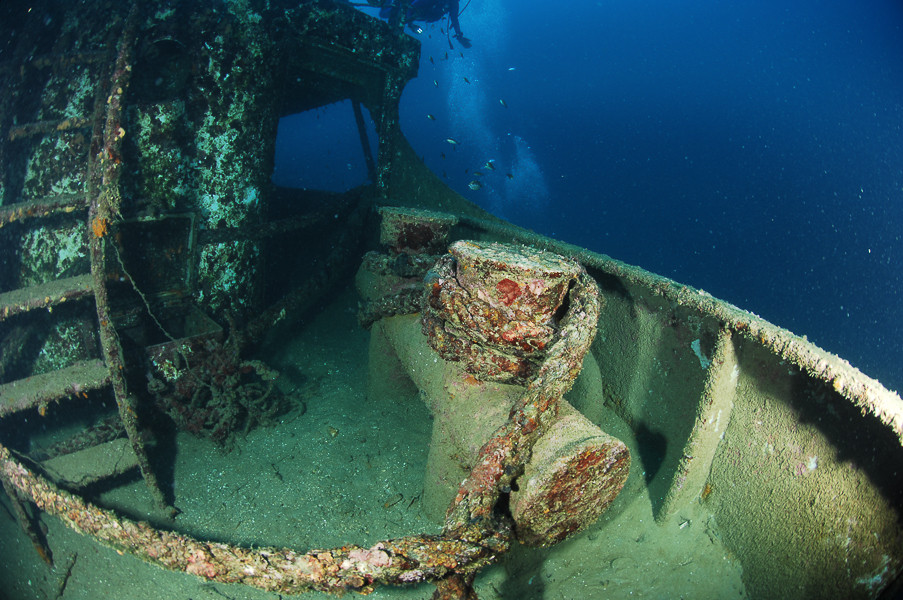
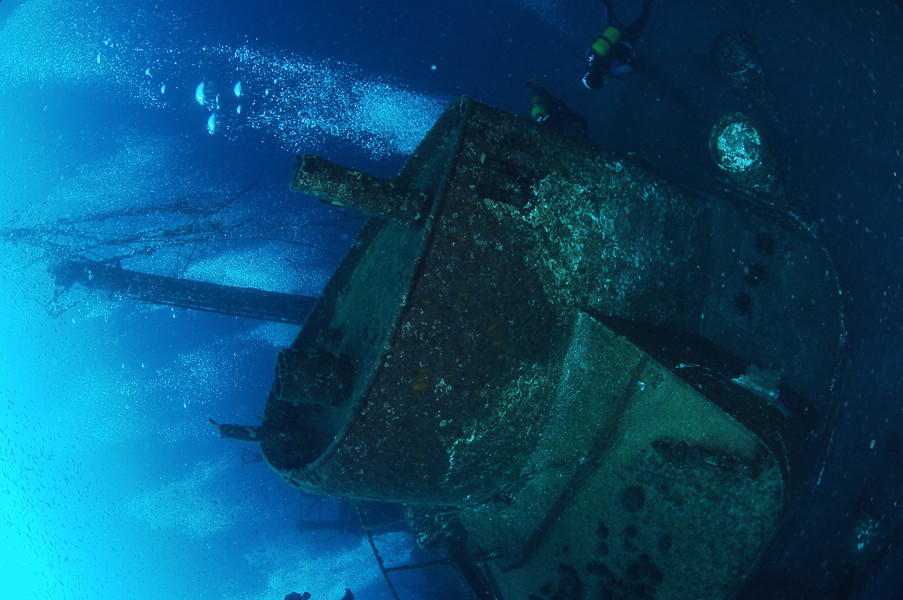
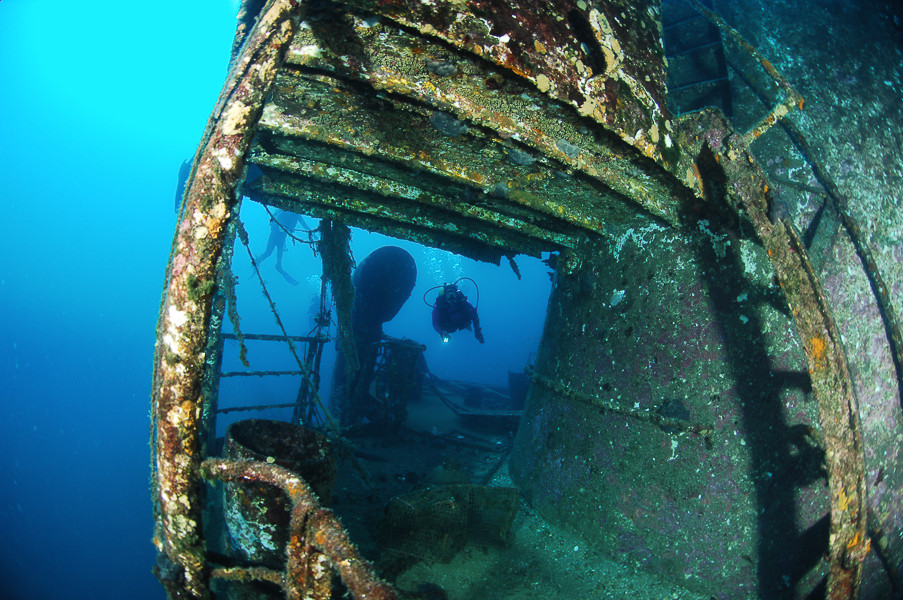
 The investment is co-financed by the Republic of Slovenia and the European Union from the European Regional Development Fund.
The investment is co-financed by the Republic of Slovenia and the European Union from the European Regional Development Fund.  H2O Globe BETA
H2O Globe BETA